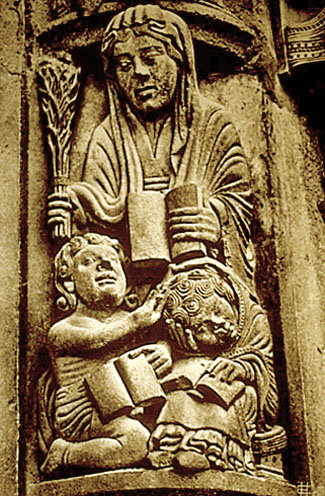PART ONE:
The Basics
The English language
is divided into four types of words:
Identifying
words, Action words, Descriptive words,
and Connecting words.
1.
Identifying words
Identifying words name things. Imagine a Martian who doesn’t
speak English (well what Martian does?). He wants to know the name of everything.
He points at a door, a chair, a desk. These are all identifying words called
Nouns. You remember nouns from
grade school; they are persons, places, things, ideas, or, in other words,
names. If someone asks, “what do you call that?” The answer you
give will be a noun.
Just
like people, nouns have nicknames. How many people call a television a television?
It is now a TV. Do you own a reclining chair? It is a recliner. Nicknames
are a shorter, more familiar form of a word. Nicknames of nouns are called
Pronouns. You don’t have
to repeat a noun numerous times. Instead, use a pronoun, which takes the place
of the noun. If you can put a name in place of a word, that word is a pronoun.
Example: He threw it to him.
Fred threw the ball to Jim.
He,
it, and him are pronouns. They take the place of Fred, ball, and Jim. Simple,
isn’t it?
2.
Action words
Now
your Martian friend can identify things, but he needs to make these things
do something. That’s where Action
words come in. Action words called Verbs
enable us to make a complete thought. In the example above, we have three
nouns – Fred, ball, and Jim. The Action word “threw” gives
the names purpose. Fred threw the ball. Without “threw” we’re
left with, well, inaction.
Now some
Action words show states of being. They come from the strange verb “be.”
We will discuss the verb “be” in greater detail later.
3.
Descriptive words
We have
names, we have action, now we need to describe the two. That’s where,
you guessed it, the Descriptive words come into play. Let’s go back to Fred
and his pal Jim. Our Martian friend is getting pretty good at identifying
things with nouns and giving them action with verbs, but he’s having
trouble being specific. Let’s help him.
Example:
Fred quickly threw the green ball to Jim.
By
adding the descriptive words “quickly” and “green”
to the sentence, we’ve shown our friend how to be specific. “Quickly”
tells how Fred threw the ball, and “green” tells which ball Fred
threw. “Quickly” describes the action (a verb) and is called an
Adverb; “green”
describes the name (a noun) and is called an Adjective.
There
are two other words in the sentence that we have to cover. “The”
describes which ball Fred threw; therefore, it is an Adjective. “To”
tells where Fred threw the ball; therefore, it is an Adverb. In grade school,
you learned the term Preposition for
words like to, for, at, against, in, about, and around. They are simply descriptive
words that act as either Adverbs or Adjectives depending on what they describe.
4.
Connecting words
Connecting
words called Conjunctions
join groups of words together logically (we hope) to speed communication.
Example:
Fred plays football. Jim plays football. Fred and
Jim play football.
Notice
the savings in words in the third sentence. “And” is a conjunction,
which is a powerful connecting tool (along with some other conjunctions “but,
or, nor, for, so, yet”).
Oh,
wait, there is one other type of word in English, which you will find at the
beginning of this sentence. “Oh” is a word that does nothing really
in the sentence. It is called an Interjection
and is punctuated with a comma or exclamation point. An interjection merely
adds emotion.
Examples:
Hey, that’s my glove. Wait! I want to go, too. Ouch! That hurts.
So,
there you have it. The parts of speech in English divided into four simple
parts: Identifying words, Action words, Descriptive words, and Connecting
words.
ELEMENTS OF
A SENTENCE
Sentence analysis
In English, we
have the following sentence types.
1. Subject
– Verb Example: He ran.
This also includes sentences with simple descriptive words added.
Example:
He ran quickly. (quickly merely describes “how” he ran).
2. Subject
– Verb – Complement Example: She is pretty. She is a doctor. Notice
how
the words pretty and doctor describe or rename the subject she.
3. Subject
– Verb – Direct Object Example: He threw the ball. Notice the ball is
what
was thrown. It is the “object” that receives the action of the
verb.
4. Subject
– Verb – Indirect Object – Direct Object
Example: He threw him the
ball.
Notice him receives the action of the verb “indirectly,”
and thus is termed
the indirect object.
OK, now what is
all this stuff? Well, use the following guidelines to help you with sentence
analysis.
1. First thing
to do when you’re analyzing a sentence is to find the verbs (all of
them).
2. Next,
find the subject of each verb by asking the question “what” or
“who” before the verb. For example, take the sentence John
ran to the store. Find the verb ran. Then
ask, “who ran?” The answer is John (it is also the subject of the verb ran).
3. Determine
what type of verb you have. There are three main types of verbs: a transitive
verb (or Action verb) takes an object (like a direct object – He threw
the rock. ), an intransitive verb does not take an object (like He ran quickly),
and an intransitive linking verb takes a complement (like she is pretty).
4. If
the verb is transitive (i.e., an action), then it will take a direct object
and maybe an indirect object.
To find a direct object, ask “what” or “whom” after
the action verb. For example, He threw the ball. Threw is the verb. It is an action, so ask, threw “what”? The answer is the ball.
Ball is the direct object.
To find an indirect object, ask “to whom” or “for whom”
after the direct object. For example, He threw him the ball. Just as above
threw is the verb. It is an action, so ask, threw “what”? The answer is the ball.
Ball is the direct object. Then ask, threw the ball “to whom”? The answer is him.
Him is the indirect object. Since you
need to have a direct object to find an indirect object, you can’t have
an indirect object without a direct object. Remember that.
5. If
the verb is intransitive, an action without an object, leave it alone. No
further analysis is needed. For example, He ran to the store. Ran is
the verb. It is an action. Test if there’s an object by asking “what”
after the action verb. He ran “what”? He didn’t run the
store. That would be a different use of the verb run. Try “whom.”
He ran “whom”? Again, no answer. That means ran is an intransitive verb.
6. Intransitive
linking verbs are most commonly forms of the verb “be.” The most
common forms – is, am, was, were, are. Sometimes sense verbs can be
linking verbs also, but only if they are not action. For example, He smells
bad. If you mean that he has trouble smelling things, that’s an action.
Can’t you just hear him sniffing?(and you would say "He smells
badly.")But, if you mean that he should bathe more regularly,
then you have a linking verb.
OK, now what to do with linking verbs. When you identify a verb as linking,
ask “what” after the linking verb to yield the compliment. For
example, He is happy. Is is the linking
verb. Ask “what” is? Answer is happy. Happy is the compliment.
Since happy is describing he,
the subject, we call it a predicate adjective.
Here’s another example. He is a doctor. Again is is the linking verb. Ask “what” is? Answer
is doctor. Doctor
is the compliment. Since doctor is renaming he, the subject, we call it a predicate nominative.
Do you
want a tip before you start? Do you remember the descriptive word called a
preposition? If not, consider the lists below.
Here
are some of the most common prepositions.
about,
above, across, after, against, among, around, as, at, before, behind, below,
beneath, beside, besides, between, beyond, but (meaning “except”)
by, down, during, except, for, from, in, into, near, of, off, on, over, past,
since, through, till, to, toward, under, until, up, with, without
Sometimes
prepositions consist of more than one word.
according
to, ahead of, as for, as far as, away from, because of, by way of, due to,
except for, instead of, out of, with respect to
When
you join prepositions with nouns, they form groups of words called prepositional
phrases, which are used to describe other words. For example, in the road,
on the table, over the mountains, under the sofa, between the ears
are called prepositional phrases. Don’t let them confuse you when you
look for the main verb or subject. In fact, is a good idea is to scratch out
the prepositional phrases in a sentence before you begin.
Here’s
an example: In the evening after dinner, Fred throws the ball against the
wall in his backyard.
Now,
let’s get rid of the prepositional phrases before we analyze the sentence.
In
the evening after dinner, Fred throws the ball against the wall
in his backyard.
All that’s
left is Fred throws the ball. Which we can easily analyze – throws is the action verb. “Who” throws gives us Fred as the subject. Since throws is an action verb, we know we’re looking for a direct object. Fred
throws “what”? Answer –
the ball, which is the direct
object.
See how
much easier that is. Remember to eliminate the prepositional phrases before
beginning to analyze the sentence.
That’s
a lot of information, but what good is it? These simple terms will be used
in Part Two to begin to help you write better immediately.
Practice
Exercises in analysis.

 This text is in three parts.
This text is in three parts.